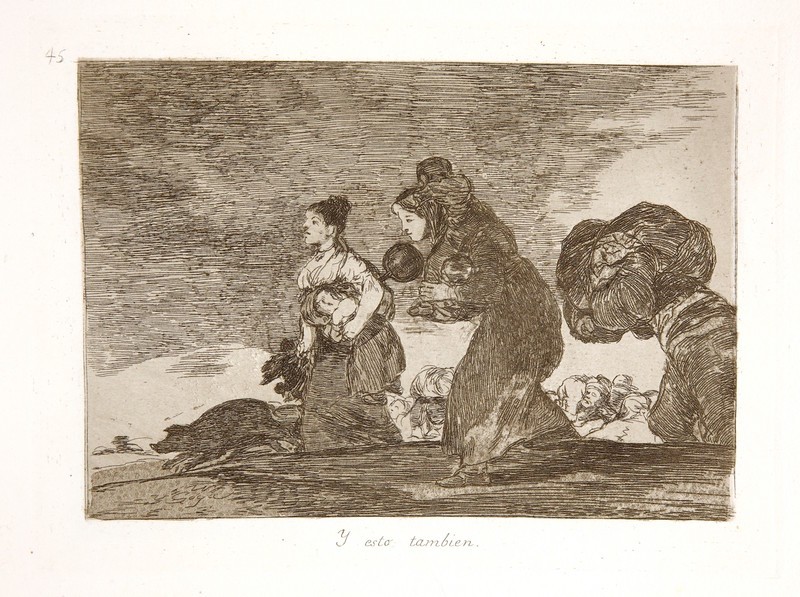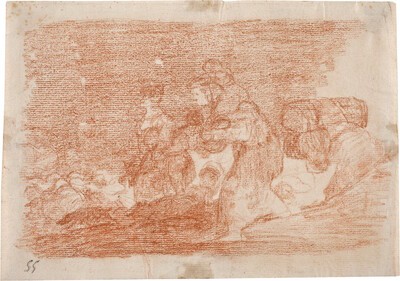- Cronología
- Ca. 1812 - 1815
- Dimensiones
- 166 x 222 mm
- Técnica y soporte
- Etching, lavis, drypoint and burin
- Reconocimiento de la autoría de Goya
- Undisputed work
- Ficha: realización/revisión
- 14 Dec 2010 / 24 May 2023
- Inventario
- 225
Goya (en el ángulo inferior izquierdo).
See Sad presentiments of what must come to pass.
The title was handwritten on the print by Goya in the first and only series that is known to have been printed at the time the works were created, which the artist gave to his friend Agustín Ceán Bermúdez. Therefore, the title was etched into the plate at a later date and left unchanged as of the first edition of the Disasters of War printed by the San Fernando Royal Academy of Fine Arts in Madrid in 1863, after the printing of the series in the possession of Ceán Bermúdez.
There is a surviving preparatory drawing for this print which is housed in the Prado Museum in Madrid.
Various figures are shown fleeing from their homes at night. In the foreground a woman carries a child on her shoulders, while a little way behind her, also in the centre of the composition, another woman carries a child under one arm and a chicken under the other. In front of this woman is a pig that accompanies them in their flight. On the right-hand side of the foreground, the shadowy figure of a man is shown wearing a hat and carrying a large, heavy bundle on his shoulders. In the background we can see the faces of other figures that are also fleeing with their belongings.
The print is related to the previous work, no. 44, I saw it (Yo lo vi): in both prints Goya emphasises his presence as an eyewitness to the events taking place. This leads the viewer to the conclusion that in the case of the other works in the series the events depicted may be the work of the artist's imagination, employed to record events that he did not witness in person. Likewise, both print no. 44 and the present work deal with the same theme, since they show the relatively common phenomenon of abandoning towns during times of war, leaving settlements in the hands of the French troops that would pillage then abandon the towns. However, the prints do not show the same event or situation, since print no. 44 depicts a daylight scene, while that recorded in no. 45 takes place at night.
The print is a continuation of the set dedicated to fleeing which begins with no. 41, They escape through the flames (Escapan entre las llamas).
La plancha se conserva en la Calcografía Nacional (cat. 296)
-
De grafiek van GoyaRijksmuseum RijksprentenkabinetAmsterdam1970from November 13th 1970 to January 17th 1971cat. 81
-
Francisco de GoyaMuseo d'Arte ModernaLugano1996exhibition celebrated from September 22nd to November 17th.cat. 45
-
Francisco Goya. Sein leben im spiegel der graphik. Fuendetodos 1746-1828 Bordeaux. 1746-1996Galerie KornfeldBern1996from November 21st 1996 to January 1997cat. 129
-
Francisco Goya. Capricci, follie e disastri della guerraSan Donato Milanese2000Opere grafiche della Fondazione Antonio Mazzottacat. 125
-
Goya. La imagen de la mujerMuseo Nacional del PradoMadrid2001from October 30th 2001 to February 10th 2002. Exhibitied also at the National Gallery of Art, Washington, March 10th to June 2nd 2002, consultant editor Francisco Calvo Serrallercat. 106
-
Goya. Opera graficaPinacoteca del Castello di San GiorgioLegnano2006exhibition celebrated from December 16th 2006 to April 1st 2007p. 73
-
Goya et la modernitéPinacothèque de ParisParís2013from October 11st 2013 to March 16th 2014cat. 84
-
2022
-
Goya, grabadorMadridBlass S.A.1918cat. 147
-
Goya engravings and lithographs, vol. I y II.OxfordBruno Cassirer1964cat. 165
-
Vie et ouvre de Francisco de GoyaParísOffice du livre1970cat. 1066
-
Catálogo de las estampas de Goya en la Biblioteca NacionalMadridMinisterio de Educación y Cultura, Biblioteca Nacional1996cat. 253
-
ParísPinacoteca de París2013p. 142
-
Goya. In the Norton Simon MuseumPasadenaNorton Simon Museum2016pp. 114-151
-
Museo de Bellas Artes de Badajoz y Diputación de Badajoz2022p. 68

